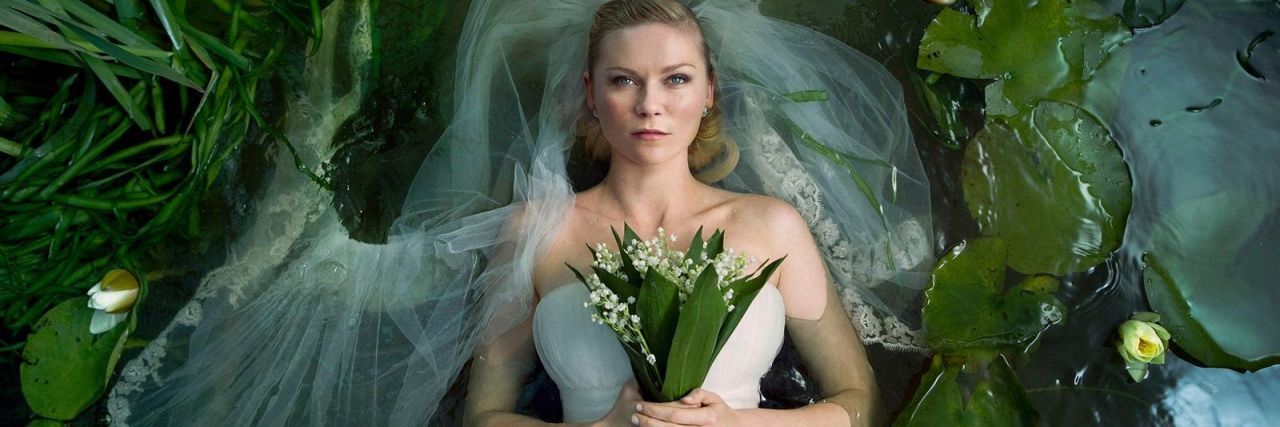It’s a blood-and-guts cacophony of sadness, a genius original screenplay and purely artistic piece of indie cinema, which resonates deeply with audiences the world over and boasts idyllic cinematography. “Melancholia” features Kirsten Dunst in the most faithful depiction of depression I have ever seen onscreen. And when it was released 10 years ago, the Lars von Trier film totally blew my mind for its indisputable lifelike portrayal of mental illness.
Why am I telling you to watch a depressing movie? Well, there is catharsis and camaraderie in seeing ourselves in what’s on the screen. Because of my agonizing experience with depression over the years, “Melancholia” resonates with me deeply.
I revisited the film in honor of its 10th anniversary, and the movie still shakes me to the core. Fair warning:
“Melancholia” is a slow burn, but worth your time. Also, I wouldn’t recommend watching it if you are in a current state of depression.
It is the second film in Danish director Lars von Trier’s “depression trilogy.” The other films in that set include “Antichrist” and “Nymphomaniac.”
This style of filmmaking can be extremely unsettling to watch. Films of this ilk for example include 2000’s drug addiction tragedy “Requiem for a Dream” and the 1971 Stanley Kubrick classic “A Clockwork Orange,” which literally depicts the torture by government of its protagonist.
While decidedly difficult to watch, these are movies that are so imaginative and so artistic they will leave an impression that will haunt you — not for their sadness — but with their greatness.
“Melancholia” stars Kirsten Dunst, Alexander Skarsgård, Kiefer Sutherland and Charlotte Gainsbourg. In a nutshell, it takes place in the moments leading up to the end of the world. It follows the lives of sisters Justine (Dunst) and Claire (Gainsbourg) and their affluent family.
Melancholia is a planet gone awry, slowly advancing toward a crash-landing on earth, destroying the world.
The movie comes in two parts, the first half focusing on the extremely extravagant wedding of Justine (Dunst) and her betrothed Michael (Skarsgård) on a luxurious estate owned by Justine’s family. Justine is surrounded by a dysfunctional family of narcissists, gluttons and self-serving aristocracy.
Part two follows the now-separated-from-Michael Justine, and a horrific depression set against the backdrop of looming armageddon.
Kirsten Dunst nails her part, carrying the film as the depressed Justine. She won Best Actress at the 2011 Cannes Film Festival for her incredible performance, for which she derived personal experience. Dunst experienced from a major depressive episode in 2008. That’s the same year of my major bipolar depressive episode, which I chronicle in a memoir.
The magic of “Melancholia” is the moviegoer actually feels Justine’s pain. It is a collective empathy that we as the audience share.
In several scenes, Justine looks disheveled and is depicted staring blankly out the window. She sleeps day and night. She is seen needing help getting into the bathtub. Sprawled out on the cold bathroom floor, her hands clenching the edge of the porcelain, Justine is slowly lifted and eased into the bath by her sister Claire. Many of us with depression struggle with the tiny task of bathing or showering, so this scene is on-point.
When Claire cooks Justine’s favorite dinner, Justine takes one bite and declares, “This tastes like ashes.” She cries deliriously at the dinner table.
“Melancholia” was inspired by a depressive episode the director experienced himself. I think that’s why it’s so true-to-life; it comes from a sincere place of personal intimacy.
Many films that cover mental illness horribly misfire, perpetuating stigmas of madness and hysteria. Think the “insane asylum” of “One Flew Over the Cuckoo’s Nest,” or the hyperbolic psychosis of Jack Nicholson’s “Heeere’s Johnny!” in Stanley Kubrick’s 1980 classic “The Shining.”
In fact, the horror genre is notorious for misrepresentation.
Psychologist Dr. Danny Wedding wrote a book called “Movies and Mental Illness.”
“‘Friday the 13th’ (1980) and ‘A Nightmare On Elm Street’ (1984) both perpetuate the misconception that people who leave psychiatric hospitals are violent and dangerous,” he writes. “Movies such as ‘The Exorcist’ (1973) suggest to the public that mental illness is the equivalent of possession by the devil; and movies such as ‘One Flew Over the Cuckoo’s Nest’ (1975) make the case that psychiatric hospitals are simply prisons in which there is little or no regard for patient rights or welfare. These films in part account for the continuing stigma of mental illness.”
Von Trier told the press at the time of the film’s release that it is “a psychological disaster movie” and “a beautiful movie about the end of the world.”
I couldn’t agree more.
“Melancholia” is now available to stream on Hulu as of 9/22/21.
Nota bene:
Another Lars von Trier film I recommend is the equally dark and depressing yet beautiful “Dancer in the Dark,” starring Icelandic singer Björk. It’s about a working class Czech immigrant living in the United States. She is going blind and finds joy in dancing and musicals. It is one of the most intense films about capital punishment. Like Dunst in “Meloncholia,” Björk also won the Best Actress accolade at Cannes. The French have good taste.

